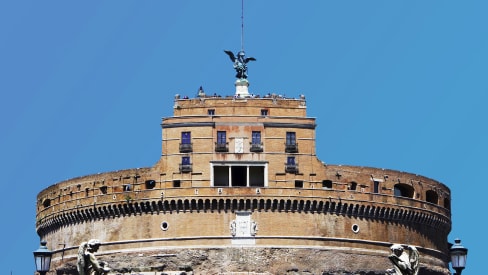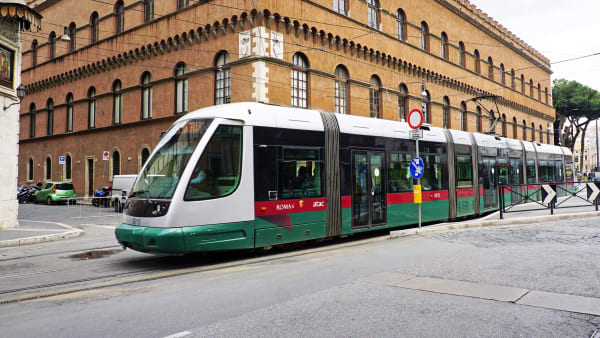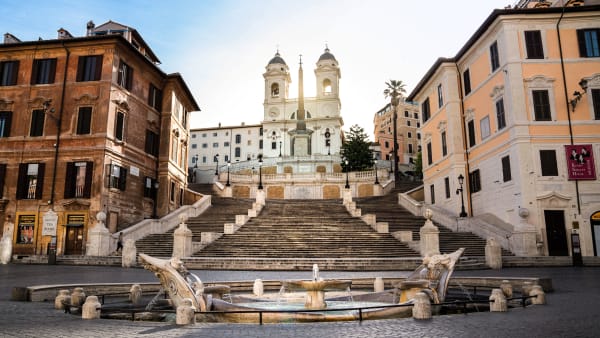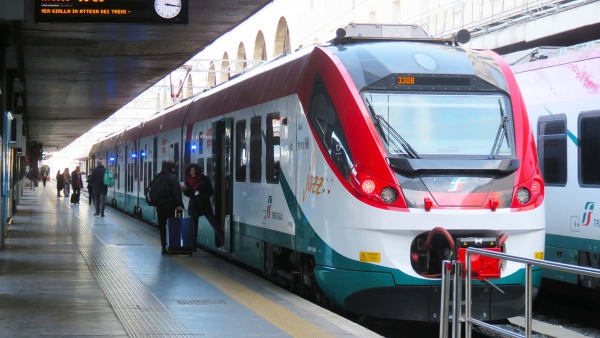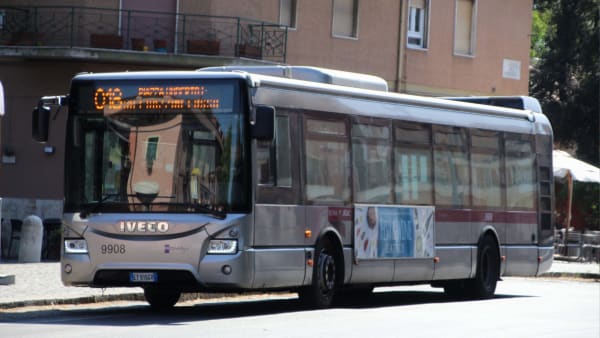Levels
Levels
As mentioned in the historical section of this article, the museum consists of various works and buildings that have been added and modified over time, which contribute to its grandeur.
The castle is composed of levels, each with its rooms, works, and monuments. Let’s run through the most significant things you can expect to see when you visit.
Level 1
Located here are il Cortile del Salvatore (the Courtyard of the Redeemer), l’Ambulacro di Bonifacio IX (the Ambulatory of Boniface IX), la Cappella dei Condannati (the Chapel of the Condemned), il Cortile delle Fucilazioni (the Courtyard of the Shooting), the Dromos, the Atrium, and the spiral ramp that runs from bottom to top of the building.
Courtyard of the Redeemer
Upon entering, the first thing you encounter is a small courtyard, il Cortile del Salvatore, which owes its name to the fifteenth-century marble bust of Christ called Busto del Salvatore. Between the walls of the square plateau and the base of the cylinder wall runs a circular corridor, l’Ambulacro di Bonifacio IX.
Ambulacrum of Boniface IX
The corridor was constructed in the late 14th century to adapt the structure to new defense requirements. On the initiative of Pope Boniface IX Tomacelli, the walls from Roman times that delineated the radial cells that originally formed the base of the mausoleum have been uncovered. Fragments of statues and architectural elements can be seen along the circular route. Through this corridor, you enter another courtyard, il Cortile delle Fucilazioni.
Courtyard of Executions
Il Cortile delle Fucilazioni is located in the northeast corner of the quadrangular walls, adjacent on the north side to the armory of Clement X, known today as the Chapel of the Condemned. The courtyard of executions received its name because non-public death sentences were carried out here.
Chapel of the Condemned
The chapel overlooks the Courtyard of Executions and was originally a porch that served as a powder magazine. Around the middle of the eighteenth century, it turned into a chapel. Its name refers to the prisoners who stayed in Castel Sant’Angelo over the centuries. Unfortunately, the chapel cannot be visited at present.
Dromos and Atrium
The entrance of the funeral procession to the imperial tomb was formed by a 12-meter long corridor with high vaults, the Dromos, which was an extension of the Pons Aelius, today’s Ponte Sant’Angelo. The corridor leads to a square cell, the Atrium, at the end of which is a large niche in which once stood an imposing statue of Emperor Hadrian. Of this statue, only the head remains and can be found in the Round Hall of the Vatican Museums.
Spiral ramp
This helical ramp begins at the Atrium and curves inside the Mausoleum, bridging a 12-meter height difference. Originally, this slope led directly to the burial chamber, called the Hall of Urns, which we will discuss later in this article. The ramp was constructed for the funeral procession that would accompany the emperor on his final journey and it has no openings on the outside except to the top.
Level 2
Located here are the Cordonata di Paolo III, the Marcia Ronda, the Bastione San Matteo, the Bastione San Marco, the Bastione San Luca, the Bastione San Giovanni, the Passetto di Borgo, the diametrical ramp, the Sala delle Urne (Hall of Urns) and the Armeria di Clemente X (the Armory of Clement X).
Cordonata di Paolo III
Near the entrance door, a ramp was built in 1545 to replace an older staircase. At the foot of the stairs is a marble sphere supported by a pillar. Originally it was engraved with three large initials intertwined with the monogram: C.T.P., or Crispo Tiberio Prefetto, cabinetmaker during the pontificate of Paul III. Along the slope, in two niches, is the bust of Emperor Hadrian.
Marcia Ronda
The walking path known as Marcia Ronda is located at the top of the outer walls, the perimeter of the ancient base of Hadrian’s Mausoleum. The path connects the four bastions (named after the four evangelists) located at the corners of the walls, which were mainly walked by the guards of Castel Sant’Angelo.
The four bastions
The construction of the four bastions (Matthew, Mark, Luke, John), located at each corner of the ancient base of Hadrian’s Mausoleum, was initiated by Pope Nicholas V between 1447 and 1455 to adapt the defensive aspect of the castle to the introduction of firearms. However, the bastion of Matthew was rebuilt fifty years later and reinforced by Urban VIII Barberini in 1625.
Passetto di Borgo
The Passetto di Borgo is a protected route that was constructed to ensure the Pope’s safety during his movements from his residence in the Vatican to Castel Sant’Angelo. It was also used by Clement VII Medici to seek refuge in the castle during the Sack of Rome in 1527. The Passetto, which is accessed through a small entrance at Bastione San Marco, is about 800 meters long.
Diametrical ramp
The passageway, long believed to be a creation from the time of Alexander VI Borgia (1492-1503), is, in reality, an ingenious work by architect Niccolò Lamberti for Boniface IX Tomacelli (1389-1404). The slope takes the form of a 16th-century staircase, rising to a height where it makes a ninety-degree turn to the left, before continuing upward, into the open air, to the level of the courtyards.
Hall of Urns
The hall (traversed by the slope mentioned above) is the fulcrum of the Roman tomb. It’s the most sacred place of the lower part of the mausoleum where the remains of the imperial family were preserved until the time of Caracalla.
On the left wall of the room is a marble tombstone with a special inscription in Latin. They are the words Emperor Hadrian is said to have dedicated to himself: “Little soul, gentle and drifting, guest and companion of my body, now you will dwell below in pallid places, stark and bare; there you will abandon your play of yore”.
Armory of Clement X
The building stands against the Bastione San Luca, on the northeast corner of the castle. In 1670 it was modified to accommodate the new prisons on the mezzanine floor, while the upper floor, similar to the bastion’s stronghold, probably retained its function as an armory. The portico on the first floor, a powder magazine, was later converted into a house of prayer, known as the Chapel of the Condemned, mentioned before.
Level 3
This level contains the prison and stores for grains and oil.
The famous prison
The prison accessible from the Courtyard of Alexander VI are a series of underground halls whose construction or expansion is probably due to Alexander VI Borgia. The main staircase leads to a large rectangular room, the Parlatoio. This is followed by a narrow, annular corridor along which the low entrance doors to three cells are arranged.
Storage areas for grains and oil
Adjacent to the prison cells are numerous niches that extend along with the layout of the structure. There are also two large halls containing 83 terracotta jars (probably dating from the Middle Ages) that were originally used to store oil. The reserve was essential for lighting the rooms but grain and food were also stored here.
Level 4
Located here are il Cortile dell’Angelo (the Courtyard of the Angel), le Armerie (the Armory), le Sale di Clemente VIII (the Halls of Clement VIII), la Sala della Giustizia (the Hall of Justice), la Sala di Apollo (the Apollo Room), la Cappella di Leone X (the Chapel of Leo X), le Sale di Clemente VII (the Halls of Clement VII), il Cortiletto di Leone X (the little room of Leo X), il Bagnetto di Clemente VII (the Bathroom of Clement VII), il Cortile di Alessandro VI (the Courtyard of Alexander VI) and le Salette di Alessandro VI (the Halls of Alexander VI).
The Courtyard of the Angel
Between 1513 and 1549, the court took on its present form. It was intended as a reception area and access to the papal apartments on the top floor of the castle.
The courtyard is rectangular and runs from north to south. On one side it borders the Armoury building and on the other side the rooms of the papal residence. In the center of the courtyard is the statue of the holy archangel Michael, to whom the castle is dedicated after his legendary appearance, as mentioned earlier.
The Armory
On the west side of the courtyard is a low building currently known as the Armory. The building consists of two levels: at the courtyard level is the lower armory and at the level of the Giretto di Alessandro VII, the upper armory.
The room was mainly used as weapon storage for the guards of the upper part of the castle.
The Halls of Clement VIII
While the Sala di Apollo performed official functions, these two halls were reserved by the popes for private use. They’re named after the pope who ordered their decoration.
The inscription of Pope Clement VII Medici (1523-1534) can still be seen today in the center of the beautiful ceilings. In the first room, you will find painted cherubs in the frieze and a door leading to il Cortiletto di Leone X (a small private room). In the second room, a door gave direct access to the Bagnetto di Clemente VII.
The Hall of Justice
Numerous trials were held in this room, often resulting in death sentences. Among others, the two humanists Pomponius Leto and Platina, the unfortunate Beatrice Cenci, and the philosopher Giordano Bruno were condemned in this room.
The large frescoes on the back wall are the work of Domenico Zaga. The paintings were altered in later periods but probably depict the appearance of the archangel Michael with his attributes of justice. The hall was also used as a chapel.
The Apollo Room
The Apollo Hall is part of the impressive palatial residence that Pope Paul III had built starting in 1534. The name of this room comes from the series of frescoes on the vault depicting episodes from the myth of Apollo. The floor has several openings, one of which is nine feet deep and may have been a trap door to quickly get rid of unwanted guests.
The Chapel and Courtyard of Leo X
Of the several chapels documented in the castle, only this one remains. It was built on the orders of Leo X Medici (1513-1521) and dedicated to Saints Cosmas and Damian, patrons of the Medici family. The room includes a carpet with a lion in the center and an altar from the early 20th century with a bas-relief of Mary with baby Jesus (carved by Raffaello da Montelupo).
There’s also a small courtyard, built around 1514, better known as “del forno” (of the oven). This is where the fire was lit to heat the bathwater of Clement VII above. Evidence of this can be seen in the opening still visible in the wall.
The Halls and the Bathroom of Clement VII
The Cortile dell’Angelo gives access to two interconnected rooms that are completely bare. The shape of the two halls of Clemens VIII has undergone several transformations over time. Recent renovations have added various architectural elements from demolished or altered parts, such as the coat of arms of Pope Altieri.
The Bagnetto di Clemente VII has a rectangular room with a bath for the papal residence. It was equipped with an advanced heating system inspired by Roman baths. The bath was connected to a furnace located on the adjacent Cortile di Leone X. Furthermore, the room is decorated with sphinxes, dolphins, and fanciful sea creatures that provide an aquatic theme.
The Courtyard and the Salette of Alexander VI
The Courtyard of Alexander VI—also called theater because of the performances held there for Pope Leo X Medici (1513-1521)—is characterized by a semicircular space in the shape of a cylinder. The building has two levels and closes the courtyard to the south. On the first floor, numerous doors give access to small coherent rooms. Above them, there’s a row of small square windows and some damaged images of gods.
The Salette is a series of small rooms in a semicircle facing the Cortile di Alessandro VI, which originally served the prisons below. Today, it houses the permanent exhibition Immagini di Castello (Images of the Castle), a selection of paintings, drawings, and prints from the museum’s collection, which illustrates the evolution of the monument over the centuries.
Level 5
On this floor, you’ll find the Loggia di Giulio II, the Giretto and Salette di Pio IV (circular corridor with small rooms), the Loggia di Paolo III, the Giretto di Alessandro VII, the Sala Paolina, the Sala del Perseo, the Sala di Amore e Psiche (Room of Cupid and Psyche), and the four armories.
The Loggia di Giulio II and the Loggia di Paolo III
The loggia overlooking the Tiber is breathtaking. Moreover, it’s the official entrance to the Sala Paolina, a frescoed space with two side wings. The structure consists of a white marble parapet, a pair of freestanding columns, and two half columns set against the jambs. The pope’s heraldic motif is repeated in the capitals of the columns. The four Latin mottoes, inscribed in painted cartouches in the vault, refer to this portico space’s function, which Julius II designed as a “loggia of blessings.”
The Loggia di Paolo III, on the other hand, looked north toward the Vatican. It also gave access to the private residences of Paul III Farnese (1534-1549). It was completed in 1543 and is characterized by five arches supported by pillars, a frieze in relief with lilies, the coat of arms of the Farnese family, and decorated parapets depicting episodes from the life of Emperor Hadrian.
The Giretto and Salette di Pio IV
The covered Giretto, built during the pontificate of Pius IV Medici (1559-1565), is an annular corridor leading out through brick arches. A series of small doors, with marble architraves with the name of the Pope Pius IIII Pont. Max. on them, give access to the second floor of the building built to close off the Courtyard of Alexander VI below. Inside are numerous small rooms (salette) that originally served the artillery and were later converted into less severe prisons.
The Giretto di Alessandro VII
This uncovered giretto is part of the annular corridor delineated by the loggias of Julius II and Paul III and accessed by the two ramps leading up from the Cortile dell’Angelo. It was built around 1657 by Alexander VII Chigi, in accordance with the western hemicycle of the castle and by analogy with the covered giretto. Along the way, there are numerous views of the west and St. Peter’s Basilica.
Sala Paolina
The Sala Paolina is undoubtedly one of the most important places in the castle, and also the reception room of the residence of Paul III Farnese (1534-1549). The majestic and imposing hall of honor was used to receive ambassadors and important visitors. Most of its decoration was inspired by Alexander the Great and St. Paul, making it one of the most important artistic heritage of sixteenth-century Rome.
Sala del Perseo
This room was the study of Paul III Farnese. It’s connected to the bedroom (la Sala di Amore e Psiche) and, by a staircase, to the Bathroom of Clement VII below. Among the various decorative elements, the figure of the archangel Michael painted in relief stands out, as does that of Perseus, the hero of Greek mythology. The frieze of frescoes consists of six panels depicting his exploits, taken from Ovid’s Metamorphoses.
The Room of Cupid and Psyche
As mentioned earlier, this was the authentic and precious bedroom of Paul III Farnese (1534-1549). It was furnished between 1545 and 1546 by Perin del Vaga and helpers.
Apart from the prominent coat of arms of Farnese, one can admire the frescoed frieze, framed by painted curtains, which is divided into nine panels with episodes from the fairy tale of Cupid and Psyche.
The armories
The four interconnected rooms named “upper armory” display only a limited selection of the National Museum of Castel Sant’Angelo’s collection of weapons, armor, and military relics, which totals about 6,000 items.
Level 6
On this level are the Corridoio Pompeiano (Pompeian corridor), the Sala della Biblioteca (Library), the Sala dell’Adrianeo (Hall of Hadrian), the Sala dei Festoni (Hall of Garlands), the Sala del Tesoro (Treasury), the Cagliostra, and the apartment of the castellan.
The Pompeian Corridor
The passageway that connects the Sala Paolina with the Sala della Biblioteca is known as the Corridoio Pompeiano because of the pictorial decoration, created in the style of Roman painting from the Augustan period, that covers it. Just over a meter wide and with barrel vaults, it was created in the 16th century from a gallery.
The Library
The room owes its name to its proximity to the most protected part of the fortress, which from the mid-15th century was intended for the papal treasury and secret archives, the Sala del Tesoro. This room, the centerpiece of the northern wing of Paolo III Farnese’s apartment, was embellished in 1544 with a luxurious decorative ensemble. On the eastern wall, above the large fireplace, on either side of the papal coat of arms, are the two imposing allegorical figures of the Church and Rome.
The Hall of Hadrian
The room was given this name on the insistence of Mariano Borgatti, the first director of the National Museum of Castel Sant’Angelo, who discovered the murals under the plaster during restoration work in 1902. Together with the adjacent Sala dei Festoni, it was one of the first rooms completed during the works promoted in Castel Sant’Angelo by Paul III Farnese (1534-1549).
The Hall of Garlands
The Sala dei Festoni refers to the continuous undulating movement suggested by the painted processions of dancing tritons and nereids, of female and male figures interspersed with unicorns, which unfold like a garland at the top of the walls.
The Treasury
This circular room was the repository for documents and valuables. Above the Sala della Giustizia, it originally formed a single niche with the Sala Rotonda above it. Some scholars identify it with the actual tomb of Emperor Hadrian. It seems that the treasure was stored in the large chest with six locks, which still stands in the center of the room.
Cagliostra
Together with the Loggia di Paolo III, this room of the castle was originally built in 1543. Later it became known as the prison of the famous adventurer and alchemist Giuseppe Balsamo, Count of Cagliostro, who was imprisoned here in 1789 for witchcraft.
The apartment of the castellan
The residence was built by order of the castellan Zenobio Savelli (1730-1752). The position of castellan represented the highest authority that resided in Castel Sant’Angelo—military administrator of operations. In effect, he was at the top of the complex defensive organization of the Papal State. With the construction of the residence, which consists of two floors, the exterior facade of the castle received its current appearance.
Level 7
On this level are the Sala Rotonda, the Sala delle Colonne (Hall of Columns), and the Terrazzo dell’Angelo (Terrace of the Angel).
Sala Rotonda
This circular room is located above the Sala del Tesoro. It can be reached by a narrow staircase from the Hadrianic period, which begins on the floor of the Library hall. Traditionally known as the site of the first medieval chapel dedicated to the Archangel Michael (hence we can see the original metal support of the statue in the center), it was later used to house the expansion of the secret archives.
Sala delle Colonne
The hall with four columns was built together with the two adjacent smaller halls (the hall of the flags of the cavalry and the hall of the flags of the assault units) under the pontificate of Benedict XIV Lambertini (1740-1758) to contain the new archive. On July 4, 1798, during the French occupation, the documents were transferred to the Vatican, their current location, using the Passetto di Borgo for this purpose.
Terrace of the Angel
The roof terrace is dominated by the bronze statue of the angel cast in 1752 by Peter Anton van Verschaffelt. At the top left is the so-called “convict” and “mercy” bell, whose sound announced executions at the time.
The terrace has been the setting for the “bonfire” or “Girandole” as Michelangelo called it, since the end of the 15th century. These fireworks are known throughout Europe and admired by many artists.


